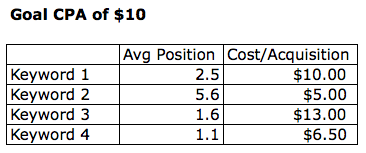Over time I’ve seen many different strategies with generating leads at an ideal cost per acquisition (CPA). The direction I see many accounts take is that there will be a “core” group of keywords that perform amazingly, a bunch of keywords that perform at the desired CPA, and a group of keywords that probably drive volume but at higher than desired CPAs. In the end they all average out to your target so all is well in the universe. While I don’t have a problem with this strategy and performance landscape, I’m here to offer a different way to look at your overall performance and account health. What I’m proposing is that you bring everything to the middle and get rid of the averages, while keeping overall profitability in mind.
Let’s start by defining goals. Most accounts should have firm numbers in mind. If you’re working on lead generation, you should know exactly what your CPA needs to be in order to drive profitable leads. Usually there is a tolerance here though and that should be what you’re seeking to find. A little higher CPA should drive more volume but have less margin. Lower and you’ll increase margins but probably won’t drive the volume. What you need to find is the sweet spot, that generates the most efficient revenue gains. With E-Commerce, you should have the same definition but often times it will be dependant on a particular product, brand, or price point and should be different across your entire catalog. In either instance, you should have firm and defined goals as the end game and this process is what will get you there.
The first step is to get rid of the notion of “high performers” or “ideal keywords.” I think in many instances people sacrifice volume at the sake of having the wonderful keywords with super low CPAs that they feel support their account. I’m not saying they don’t exist but if you have a keyword that is performing far better than ideal CPA and is in average position 8 with a .16% CTR, you’re not getting the most out of that keyword and should make an adjustment. Check the overly simplified chart below:
While these numbers are all arbitrary, I wanted to show the difference between ideal and not. On the chart, keywords 1 & 4 are performing well. Keyword 1 is good because it is running at exactly CPA goal. Keyword 4 is good because it doesn’t have any room to grow average position through bid manipulation. Your strategy there would be to improve CTR through ad testing, which will provide it more opportunities to convert (while hopefully maintaining conversion rates).
On the other side of the coin, Keyword 3 clearly isn’t performing at goal. This still doesn’t mean you should cut bait. It’s in a relatively high position so you should be able to adjust its bid down and still maintain sales while keeping it in line with your CPA threshold. Keyword 2 also needs some attention. Yes, its CPA is well within goal but it’s also in average position 5.6 and to me that says I can almost certainly drive more volume by increasing its position so that’s what I would recommend. Along with that, what you’ll need to do is analyze exactly what the volume benefit has on your overall profitability. To illustrate this, I created another, slightly more complicated chart.
In this chart, I kept impressions and conversion rates equal (they were 10,000 and 3% respectively). Gross profit/sale is pre-advertising profit margin per sale. Net profit total is the amount of sales, multiplied by per sale profit, and then minus the advertising costs. You can see that, while all three positions are profitable, test position 1 is driving the most actual profit (profit per keyword). The control position has the lowest CPA but the lack of volume is hurting the bottom line. Test position 2 is driving more volume but only marginally better and the increase in cost outweighs the volume gain.
While this example is exaggerated for effect, doing a similar profit analysis when testing your CPAs and positions will put you in a much better spot, while impacting the bottom line for the positive. The takeaway from all of this is don’t take your CPAs for granted and always try to squeeze the most profit out of your keywords. Sometimes that means pushing them and sometimes that means relaxing your bids but in both instances, you should always have a reference for the overall impact on the bottom line.






